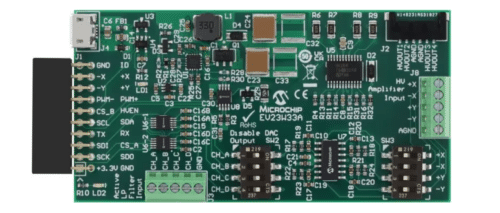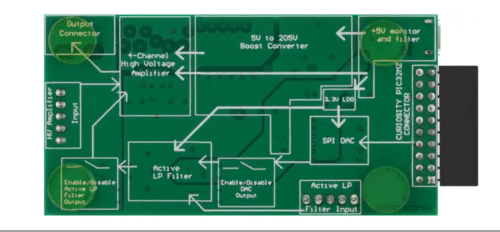This design enables linear control of the deflection angle of an electrostatic MEMS mirror (up to 2D) in industrial or portable commercial applications.

Micro-electro-mechanical systems (MEMS) mirror drivers are essential in contemporary optical technologies. They are vital in various applications, including advanced telecommunications, laser-based projectors, medical imaging, and autonomous vehicle navigation. These drivers enable precise, rapid, and reliable control of MEMS mirrors, allowing for accurate manipulation of light beams. This precision is crucial for creating compact, energy-efficient, and high-resolution devices, making MEMS mirror drivers key to advancing optical systems and their integration into everyday technology.
The MEMS Mirror Driver Reference Design by Microchip Technologies is designed for industrial dynamic lighting, such as visual messaging solutions for robotics, industrial LiDAR (Light Detection and Ranging), consumer augmented reality or virtual reality (AR/VR) devices, 3D perception sensing, µProjectors, and medical imaging, including Optical Coherence Tomography (OCT). It is suitable for applications where MEMS-based mirrors are used for laser beam steering solutions.

It can generate high-voltage waveforms required for driving an electrostatic MEMS mirror with low-voltage input signals. The input signals can originate from digital-to-analog converters (DACs) with onboard second-order low-pass filters or directly from external DACs or analog front-ends (AFEs), offering flexibility in the evaluation and meeting diverse customer requirements. The board can operate in a hardware standalone mode or be controlled by an external microcontroller (MCU) or field-programmable gate array (FPGA) for extended functionality through the onboard 20-pin socket for connecting I2C and SPI interfaces. Implementing LiDAR in design provides several benefits, including compatibility with low-voltage input signals for energy efficiency and an onboard 20-pin socket for easy integration with MCUs, MPUs, or FPGAs.
The HV9150 is a high-voltage output hysteretic mode step-up DC/DC controller designed for applications requiring high-voltage outputs. The MCP48CVB22 is a dual-channel, 12-bit, volatile memory digital-to-analog converter (DAC) with an SPI interface, suitable for precision analog output applications. The MCP809 is a microcontroller supervisory circuit with a push-pull active low output, ensuring that the system voltage reaches an appropriate level and stabilizes before operation. The HV264 is a quad high-voltage amplifier array, ideal for applications requiring multiple high-voltage amplification channels. The MCP4561 is an 8-bit single digital potentiometer with non-volatile memory (NVM) and an I2C interface, suitable for calibration and adjustment applications in automotive environments, as it is AEC-Q100 qualified. The MIC5283 is an ultra-low quiescent current, high-PSRR (power supply rejection ratio) linear regulator that can handle input voltages up to 120V and provide an output current of 150mA, making it suitable for high-voltage applications with strict power efficiency requirements. Lastly, the MCP6404 is a quad, low-power operational amplifier with a supply voltage of 1.8V and a bandwidth of 1MHz, designed for low-power applications requiring multiple op-amps, such as sensor interfacing and signal conditioning.
Microchip Technologies has thoroughly tested this reference design, which includes a Design Guide, Bill of Materials (BOM), schematics, solution diagram and more. Please visit the company’s website for further information on this reference design. To explore this design in greater detail, click here.





